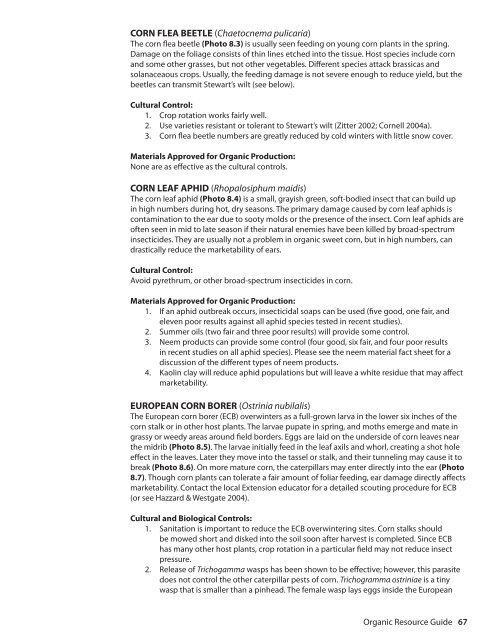Resource Guide for Organic Insect and Disease ... - Cornell University
Resource Guide for Organic Insect and Disease ... - Cornell University
Resource Guide for Organic Insect and Disease ... - Cornell University
You also want an ePaper? Increase the reach of your titles
YUMPU automatically turns print PDFs into web optimized ePapers that Google loves.
CORN FLEA BEETLE (Chaetocnema pulicaria)<br />
The corn flea beetle (Photo 8.3) is usually seen feeding on young corn plants in the spring.<br />
Damage on the foliage consists of thin lines etched into the tissue. Host species include corn<br />
<strong>and</strong> some other grasses, but not other vegetables. Different species attack brassicas <strong>and</strong><br />
solanaceaous crops. Usually, the feeding damage is not severe enough to reduce yield, but the<br />
beetles can transmit Stewart’s wilt (see below).<br />
Cultural Control:<br />
1. Crop rotation works fairly well.<br />
2. Use varieties resistant or tolerant to Stewart’s wilt (Zitter 2002; <strong>Cornell</strong> 2004a).<br />
3. Corn flea beetle numbers are greatly reduced by cold winters with little snow cover.<br />
Materials Approved <strong>for</strong> <strong>Organic</strong> Production:<br />
None are as effective as the cultural controls.<br />
CORN LEAF APHID (Rhopalosiphum maidis)<br />
The corn leaf aphid (Photo 8.4) is a small, grayish green, soft-bodied insect that can build up<br />
in high numbers during hot, dry seasons. The primary damage caused by corn leaf aphids is<br />
contamination to the ear due to sooty molds or the presence of the insect. Corn leaf aphids are<br />
often seen in mid to late season if their natural enemies have been killed by broad-spectrum<br />
insecticides. They are usually not a problem in organic sweet corn, but in high numbers, can<br />
drastically reduce the marketability of ears.<br />
Cultural Control:<br />
Avoid pyrethrum, or other broad-spectrum insecticides in corn.<br />
Materials Approved <strong>for</strong> <strong>Organic</strong> Production:<br />
1. If an aphid outbreak occurs, insecticidal soaps can be used (five good, one fair, <strong>and</strong><br />
eleven poor results against all aphid species tested in recent studies).<br />
2. Summer oils (two fair <strong>and</strong> three poor results) will provide some control.<br />
3. Neem products can provide some control (four good, six fair, <strong>and</strong> four poor results<br />
in recent studies on all aphid species). Please see the neem material fact sheet <strong>for</strong> a<br />
discussion of the different types of neem products.<br />
4. Kaolin clay will reduce aphid populations but will leave a white residue that may affect<br />
marketability.<br />
EUROPEAN CORN BORER (Ostrinia nubilalis)<br />
The European corn borer (ECB) overwinters as a full-grown larva in the lower six inches of the<br />
corn stalk or in other host plants. The larvae pupate in spring, <strong>and</strong> moths emerge <strong>and</strong> mate in<br />
grassy or weedy areas around field borders. Eggs are laid on the underside of corn leaves near<br />
the midrib (Photo 8.5). The larvae initially feed in the leaf axils <strong>and</strong> whorl, creating a shot hole<br />
effect in the leaves. Later they move into the tassel or stalk, <strong>and</strong> their tunneling may cause it to<br />
break (Photo 8.6). On more mature corn, the caterpillars may enter directly into the ear (Photo<br />
8.7). Though corn plants can tolerate a fair amount of foliar feeding, ear damage directly affects<br />
marketability. Contact the local Extension educator <strong>for</strong> a detailed scouting procedure <strong>for</strong> ECB<br />
(or see Hazzard & Westgate 2004).<br />
Cultural <strong>and</strong> Biological Controls:<br />
1. Sanitation is important to reduce the ECB overwintering sites. Corn stalks should<br />
be mowed short <strong>and</strong> disked into the soil soon after harvest is completed. Since ECB<br />
has many other host plants, crop rotation in a particular field may not reduce insect<br />
pressure.<br />
2. Release of Trichogamma wasps has been shown to be effective; however, this parasite<br />
does not control the other caterpillar pests of corn. Trichogramma ostriniae is a tiny<br />
wasp that is smaller than a pinhead. The female wasp lays eggs inside the European<br />
<strong>Organic</strong> <strong>Resource</strong> <strong>Guide</strong> 67







